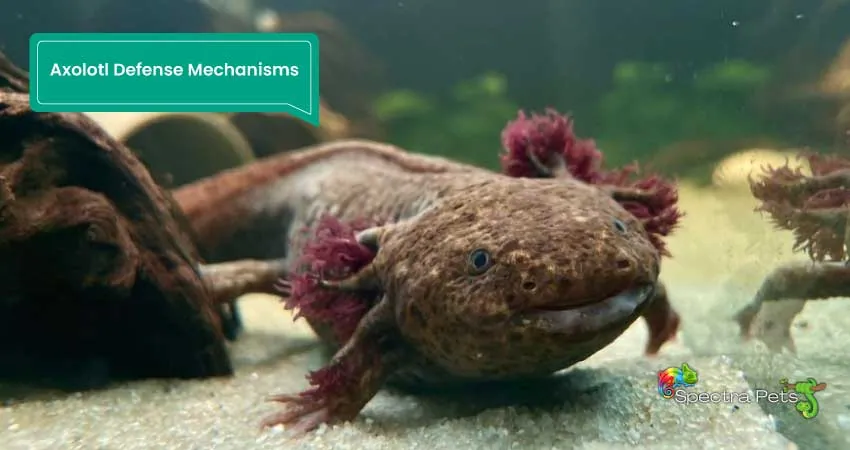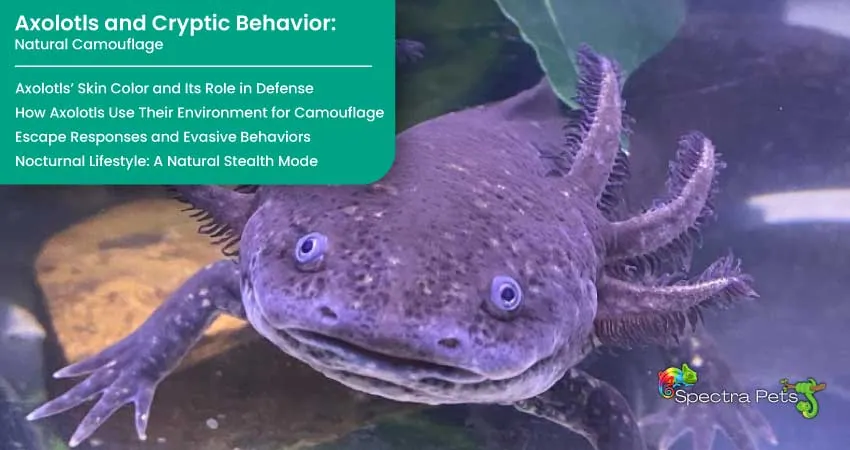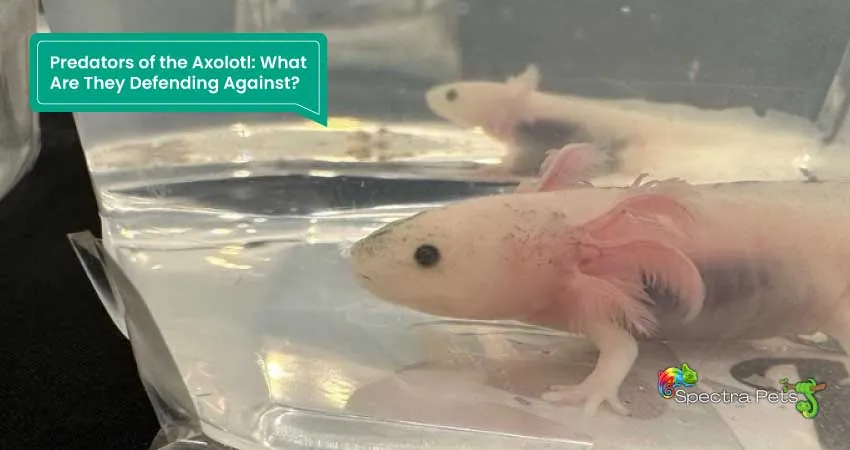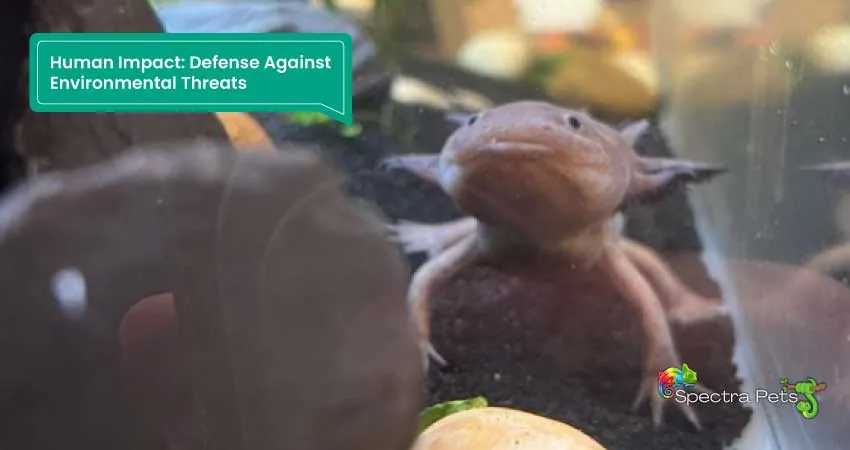The axolotl is an unusual and captivating creature. A type of salamander native to the lakes surrounding Mexico City, axolotls are known for their seemingly perpetual youth. Unlike most salamanders, axolotls never undergo a full metamorphosis, retaining their aquatic, larval form throughout their lives. These animals, with their fringed gills and wide, endearing smiles, are biological marvels, particularly famous for their regenerative abilities.
In a world filled with potential dangers, predators, and environmental threats, a critical question arises: How do axolotls defend themselves? Axolotls defend themselves through a multi-faceted approach. Their primary defense mechanisms include physical adaptations such as remarkable regenerative capabilities and skin pigmentation alteration for camouflage, chemical defenses through the production of noxious substances, behavioral strategies like rapid escape responses, and adopting a nocturnal lifestyle to minimize predation risk.
This article unravels the science behind the axolotl’s remarkable resilience. From their astonishing ability to regenerate limbs and other organs, to the production of unique chemical deterrents, and their behavior and interactions with humans – including in captive environments. As we navigate through this exploration, we’ll uncover how these extraordinary creatures manage to survive and adapt, offering us valuable insights into one of nature’s most intriguing amphibians.
Axolotl Defense Mechanisms: An Overview

Before diving into specifics, let’s establish an overall picture of axolotl defense mechanisms. These creatures employ a multifaceted defense strategy, consisting of physical adaptations, chemical strategies, behavioral tactics, and responses to human interaction. This array of tactics is not a one-size-fits-all approach; it is a nuanced, adaptable response to a variety of threats.
| Defense Mechanism | Description | Purpose |
|---|---|---|
| Regenerative Abilities | Axolotls can regenerate limbs, spinal cord, heart, and other organs due to blastemal cells. | Allows axolotls to recover from severe injuries, thereby maintaining their ability to move, hunt, and reproduce. |
| Camouflage | Skin coloration of axolotls, especially wild types, blends seamlessly with their environment. | Helps axolotls to hide from predators, merging with surrounding rocks and aquatic plants. |
| Chemical Defense | Secretion of a distasteful substance from their skin when handled or attacked. | Deters predators by making axolotls unappealing as a meal. |
| Rapid Escape Responses | Swift and effective swimming maneuvers to evade predators. | Allows axolotls to quickly reach safety during a predatory attack. |
| Nocturnal Lifestyle | Axolotls are most active during the night. | Reduces visibility to predators by being active when potential threats are less likely to be active. |
| Stress-Induced Responses | Includes increased mucus production and altered heart rate during a threat. | Prepares the axolotl for rapid action, making it slippery and hard for a predator to grasp. |
Axolotls’ Primary Defense Mechanism: Regeneration

One of the most astonishing aspects of axolotls is their ability to regenerate lost body parts—a capability far beyond that of most other animals. But what is the science behind this extraordinary ability? And how does it serve as a defense mechanism?
Axolotls can regenerate not only limbs but also spinal cord, heart, and other organs. This extraordinary ability is due to a high concentration of a specific type of cell, known as blastemal cells. When an axolotl loses a body part, these cells mobilize to the wound site. There, they multiply and differentiate into the various cell types needed to form a new limb, essentially rebuilding it from scratch.
According to a study published in the Journal of Experimental Biology, axolotls regenerate a lost limb in stages. These stages are:
- Wound Healing: The initial closure of the wound and the formation of a wound epidermis.
- Blastema Formation: The accumulation of blastemal cells at the wound site, forming a structure called a blastema.
- Redifferentiation: Blastemal cells differentiate into specific cell types, forming new muscles, bones, and skin, among other structures.
How Regeneration Serves as a Defense Mechanism
Regeneration in axolotls is not just a fascinating biological process; it is a crucial survival strategy. When faced with a predator, an axolotl might lose a limb in an attack. However, the ability to regenerate lost body parts allows axolotls to recover fully from such injuries, maintaining their ability to move, hunt, and reproduce.
In practical terms, imagine an axolotl losing its limb to a predatory fish. Instead of becoming an easy future target, the axolotl will regrow that limb, restoring its full mobility and increasing its chances of escaping future attacks. It’s a remarkable form of self-preservation that effectively deters predators from viewing axolotls as easy prey.
Tip for Axolotl Owners: If you are a pet owner with an axolotl, it’s important to provide a stress-free environment to support their regeneration process. Avoid handling them excessively during this period and ensure their water is clean and free of contaminants. Regular water changes and careful monitoring of water parameters are key.
Axolotls and Cryptic Behavior: Natural Camouflage

The coloration of an axolotl is not merely a matter of appearance; it is a significant aspect of their defense strategy. In this section, we will explore how the axolotl’s skin color and its interaction with the environment contribute to its ability to evade predators through effective camouflage.
Axolotls’ Skin Color and Its Role in Defense
Axolotls come in a variety of colors, from wild types, which are a mix of greens, browns, and blacks, to leucistic (pale with pink eyes), golden albino, and other varieties. Wild type axolotls, with their earthy tones, blend seamlessly with their natural environment. This camouflage allows them to hide from predators, essentially merging with the surrounding rocks and aquatic plants.
When a predator such as a large fish or bird approaches, the axolotl’s natural coloration makes it difficult to distinguish from the surroundings, providing it a critical window of time to escape or avoid detection altogether.
How Axolotls Use Their Environment for Camouflage
Axolotls are experts at using their environment to their advantage. They often position themselves among rocks and plants or bury themselves in the substrate to further conceal their presence. By aligning their bodies with the natural lines and shapes in their environment, they break up their outline, a strategy known as disruptive coloration.
Research has shown that axolotls are quite adept at choosing locations that best match their coloration, an ability known as background matching. This is not merely a passive process; axolotls actively seek out these areas in their environment, demonstrating a keen awareness of their own appearance and how it can be used defensively.
Escape Responses and Evasive Behaviors
When confronted by a predator, axolotls can execute quick and effective escape maneuvers.
Their streamlined bodies enable them to swim rapidly through water. An axolotl threatened by a predator will often dart quickly, using a rapid undulating motion, towards a hiding spot. During this escape response, their primary goal is to reach safety, which might be under a rock, within aquatic plants, or in a burrow.
In a research setting, axolotls have been observed to accelerate to speeds up to 0.6 meters per second during escape maneuvers.
Nocturnal Lifestyle: A Natural Stealth Mode
Axolotls are primarily nocturnal, meaning they are most active during the night. This lifestyle is not a coincidence; it is a strategic choice that reduces their visibility to predators.
By being active when most of their predators are less active, axolotls reduce the chance of encounters with threats. This lifestyle is akin to a perpetual stealth mode, which is essentially one of their most effective defense strategies.
Axolotls and Stress-Induced Responses

When faced with a threat, axolotls exhibit a series of physiological responses. For example, they may increase mucus production, which can make them slippery and harder for a predator to grasp. Their heart rate may increase, preparing their bodies for rapid action—either a swift escape or a defensive lunge.
One notable stress response in axolotls is the secretion of a substance from their skin when handled or attacked. This substance is distasteful to predators, making axolotls less appealing as a meal.
These stress-induced changes are more than mere reactions; they are vital components of the axolotl’s defense strategy. The increased mucus production, for example, can allow an axolotl to slip from the grasp of a predator, turning a near-certain capture into a successful escape.
Predators of the Axolotl: What Are They Defending Against?

Axolotls in the wild face a range of predators, including large fish such as tilapia and perch, as well as birds like herons that hunt in their aquatic environment. In captivity, axolotls are generally safe from these threats, but they can be at risk if housed with incompatible tank mates.
Knowing what axolotls are defending against provides context for their various defense strategies. For example, their ability to regenerate may be particularly crucial given the types of injuries they might sustain from the bites of large fish.
Human Impact: Defense Against Environmental Threats

Sadly, axolotls are critically endangered in the wild due largely to human activities. Pollution and habitat loss are significant threats. Polluted water can impact an axolotl’s health and its ability to regenerate, while loss of habitat reduces the safe spaces where axolotls can hide and reproduce.
Governments and organizations are increasingly working to protect axolotls. This includes efforts to clean and preserve the remaining wild habitats of axolotls, as well as breeding programs in captivity to maintain their populations.
Conclusion
Axolotls’ multifaceted defense mechanisms—from their remarkable regenerative abilities to their cryptic behavior and stress-induced physiological responses—showcase the remarkable adaptations of this unique creature. In a rapidly changing world, understanding and protecting these fascinating animals is more important than ever.
